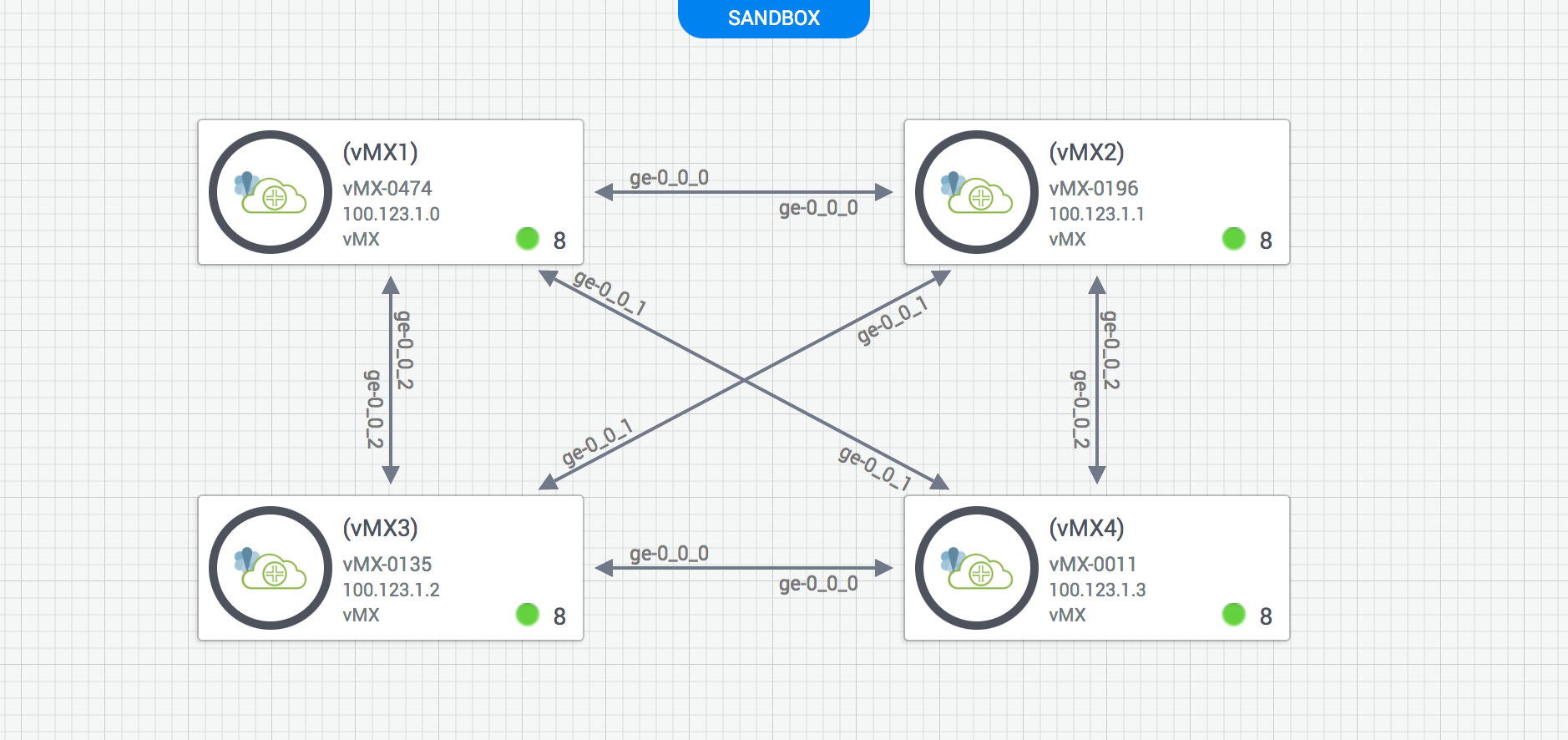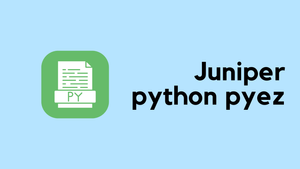In the previous post, we discussed about the single-area OSPF and Type-1, Type-2 LSAs. This article focuses on multi-area OSPF and Type-3 Summary LSAs. I highly recommend you to read my previous post here:

Diagram

Assumptions
- You are already familiar with Junos CLI
- You have a basic understanding of OSPF
- You have read the previous single-area OSPF post
Summary
- Multi-area OSPF
- OSPF Database
- Type-3 Summary LSA
Multi-area OSPF
OSPF uses areas to simplify administration and reduce CPU/memory resources. Having a multi-area OSPF decreases the size of the Link State Database and limits the propagation of link state updates when a topology change is detected. All the routers in the same area should have the same LSDB.
In the diagram above, multi-area OSPF is shown. vMX1, vMX2, vMX3 and vMX4 are ABRs because they have interfaces in area-0 and area-1 or 2.
Type-3 Summary LSA
Type-3 Summary LSAs are generated by ABR and flooded into directly connected Areas. Summary LSAs describe Inter-Area destinations. As we discussed on the previous post, Type 1 LSAs are not flooded into other areas. So, ABR uses Type-3 LSAs to inform other areas about prefixes learnt in its area.
Let's look at the OSPF database from vMX1 perspective. vMX1 is an ABR connected to both Area-0 and Area-1. Since its an ABR, it creates and floods Summary LSAs into both area-0 and area-1.
jcluser@vMX1> show ospf database
OSPF database, Area 0.0.0.0
Type ID Adv Rtr Seq Age Opt Cksum Len
Router *10.100.100.1 10.100.100.1 0x80000005 120 0x22 0x5b43 60
Router 10.100.100.2 10.100.100.2 0x80000004 126 0x22 0x1d6c 60
Router 10.100.100.3 10.100.100.3 0x80000004 136 0x22 0x2139 60
Router 10.100.100.4 10.100.100.4 0x80000004 126 0x22 0xa1c6 60
Network 10.100.12.2 10.100.100.2 0x80000001 126 0x22 0xd669 32
Network 10.100.14.2 10.100.100.4 0x80000001 126 0x22 0xc871 32
Network 10.100.23.2 10.100.100.3 0x80000001 146 0x22 0x6fc2 32
Network 10.100.34.2 10.100.100.4 0x80000001 140 0x22 0x81c 32
Summary *10.100.13.0 10.100.100.1 0x80000003 110 0x22 0x8664 28
Summary 10.100.13.0 10.100.100.3 0x80000003 110 0x22 0x7a6e 28
Summary *10.100.15.0 10.100.100.1 0x80000004 115 0x22 0x6e79 28
Summary 10.100.15.0 10.100.100.3 0x80000003 110 0x22 0x6e77 28
Summary 10.100.24.0 10.100.100.2 0x80000004 119 0x22 0x5d8 28
Summary 10.100.24.0 10.100.100.4 0x80000004 120 0x22 0xf8e2 28
Summary 10.100.26.0 10.100.100.2 0x80000005 119 0x22 0xeced 28
Summary 10.100.26.0 10.100.100.4 0x80000004 120 0x22 0xeceb 28
Summary *10.100.35.0 10.100.100.1 0x80000002 110 0x22 0x9f35 28
Summary 10.100.35.0 10.100.100.3 0x80000004 125 0x22 0x854c 28
Summary 10.100.46.0 10.100.100.2 0x80000003 119 0x22 0x1ea9 28
Summary 10.100.46.0 10.100.100.4 0x80000006 120 0x22 0x2c1 28
Summary *10.100.100.5 10.100.100.1 0x80000001 115 0x22 0x97f8 28
Summary 10.100.100.5 10.100.100.3 0x80000001 125 0x22 0x8b03 28
Summary 10.100.100.6 10.100.100.2 0x80000002 124 0x22 0x8508 28
Summary 10.100.100.6 10.100.100.4 0x80000001 138 0x22 0x7b11 28
OSPF database, Area 0.0.0.1
Type ID Adv Rtr Seq Age Opt Cksum Len
Router *10.100.100.1 10.100.100.1 0x80000005 112 0x22 0x3549 48
Router 10.100.100.3 10.100.100.3 0x80000005 113 0x22 0xbe92 48
Router 10.100.100.5 10.100.100.5 0x80000004 118 0x22 0xd68b 60
Network 10.100.13.2 10.100.100.3 0x80000001 113 0x22 0xcf6d 32
Network 10.100.15.2 10.100.100.5 0x80000001 118 0x22 0xc175 32
Network 10.100.35.2 10.100.100.5 0x80000001 131 0x22 0x120 32
Summary *10.100.12.0 10.100.100.1 0x80000006 110 0x22 0x8b5d 28
Summary 10.100.12.0 10.100.100.3 0x80000003 109 0x22 0x8f59 28
Summary *10.100.14.0 10.100.100.1 0x80000006 110 0x22 0x7571 28
Summary 10.100.14.0 10.100.100.3 0x80000003 109 0x22 0x796d 28
Summary *10.100.23.0 10.100.100.1 0x80000003 110 0x22 0x22bd 28
Summary 10.100.23.0 10.100.100.3 0x80000005 109 0x22 0x8d4 28
Summary *10.100.24.0 10.100.100.1 0x80000002 120 0x22 0x19c6 28
Summary 10.100.24.0 10.100.100.3 0x80000001 137 0x22 0xfcf 28
Summary *10.100.26.0 10.100.100.1 0x80000001 120 0x22 0x5d9 28
Summary 10.100.26.0 10.100.100.3 0x80000001 137 0x22 0xf8e3 28
Summary *10.100.34.0 10.100.100.1 0x80000004 110 0x22 0xa62d 28
Summary 10.100.34.0 10.100.100.3 0x80000005 109 0x22 0x8e43 28
Summary *10.100.46.0 10.100.100.1 0x80000002 120 0x22 0x26a3 28
Summary 10.100.46.0 10.100.100.3 0x80000001 137 0x22 0x1cac 28
Summary *10.100.100.1 10.100.100.1 0x80000002 179 0x22 0xb3e0 28
Summary 10.100.100.1 10.100.100.3 0x80000002 114 0x22 0xbbd4 28
Summary *10.100.100.2 10.100.100.1 0x80000001 120 0x22 0xb5dd 28
Summary 10.100.100.2 10.100.100.3 0x80000001 137 0x22 0xa9e7 28
Summary *10.100.100.3 10.100.100.1 0x80000002 120 0x22 0xb3dc 28
Summary 10.100.100.3 10.100.100.3 0x80000002 182 0x22 0x93fc 28
Summary *10.100.100.4 10.100.100.1 0x80000002 120 0x22 0x9ff0 28
Summary 10.100.100.4 10.100.100.3 0x80000001 137 0x22 0x95f9 28
Summary *10.100.100.6 10.100.100.1 0x80000002 120 0x22 0x95f7 28
Summary 10.100.100.6 10.100.100.3 0x80000002 120 0x22 0x8902 28I'm jumping straight into Summary LSAs, as we covered Type-1 & 2 in the previous post. We can see 16 X Summary LSAs in Area-0 and 24 x LSAs in Area-1. All the Summary LSAs are generated by vMX1, vMX2, vMX3 and vMX4 and flooded into areas they are connected to.
Summary LSAs in Area-0
Area-1 and Area-2 each has 3 x physical links/networks and one loopback interface. So, each ABR creates 4 x Summary LSA and flood it into Area-0.

jcluser@vMX1> show ospf database summary
Area 0.0.0.0:
4 Router LSAs
4 Network LSAs
16 Summary LSAsFor example, vMX5 creates a router LSA and floods within area-1. vMX1 is part of area-1 so, vMX1 will store this in its OSPF Database. Other Routers in this OSPF domain need to know about the networks connected to vMX5. So, vMX1 will create a Type-3 summary LSA for each network and flood it into Area-0. This LSA will also flood into other OSPF areas. On the other hand, vMX3 would do the same thing by creating and flooding Type-3 LSA for the networks connected to vMX5.
Summary LSAs in Area-1

jcluser@vMX1> show ospf database summary area 0.0.0.1
Area 0.0.0.1:
3 Router LSAs
3 Network LSAs
24 Summary LSAsThere are 24 Summary LSAs in Area-1.
- 4 x Loopback interfaces in area-0 (First column)
- 4 x physical interfaces in area-0 (Second column)
- 1 x loopback interface in area-2 (Third column, highlighted in Grey)
- 3 x physical interfaces in area-2 (Third column, highlighted in Grey)
So, vMX1 & vMX2 each creates 12 Summary LSAs and flood it into Area-1. Now, vMX5 knows how to reach all the other networks in Area-0 and Area-2.
Let's verify the Summary LSAs being sent out to vMX5 by vMX1.
jcluser@vMX5> show ospf database netsummary advertising-router 10.100.100.1
OSPF database, Area 0.0.0.1
Type ID Adv Rtr Seq Age Opt Cksum Len
Summary 10.100.12.0 10.100.100.1 0x80000001 168 0x22 0x9558 28
Summary 10.100.14.0 10.100.100.1 0x80000001 168 0x22 0x7f6c 28
Summary 10.100.23.0 10.100.100.1 0x80000001 168 0x22 0x26bb 28
Summary 10.100.24.0 10.100.100.1 0x80000002 357 0x22 0x19c6 28
Summary 10.100.26.0 10.100.100.1 0x80000001 368 0x22 0x5d9 28
Summary 10.100.34.0 10.100.100.1 0x80000001 168 0x22 0xac2a 28
Summary 10.100.46.0 10.100.100.1 0x80000002 357 0x22 0x26a3 28
Summary 10.100.100.1 10.100.100.1 0x80000001 168 0x22 0xb5df 28
Summary 10.100.100.2 10.100.100.1 0x80000001 168 0x22 0xb5dd 28
Summary 10.100.100.3 10.100.100.1 0x80000001 168 0x22 0xb5db 28
Summary 10.100.100.4 10.100.100.1 0x80000001 168 0x22 0xa1ef 28
Summary 10.100.100.6 10.100.100.1 0x80000002 357 0x22 0x95f7 28Reference

Thanks for reading
As always, your feedback and comments are more than welcome



